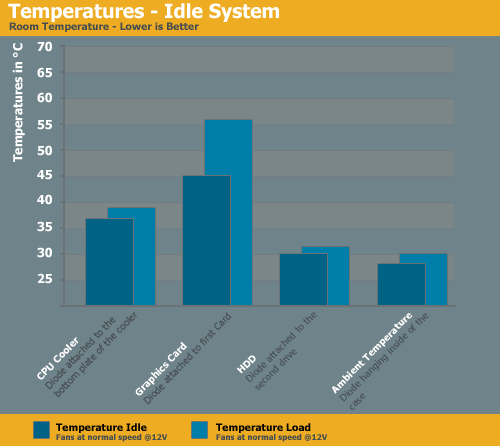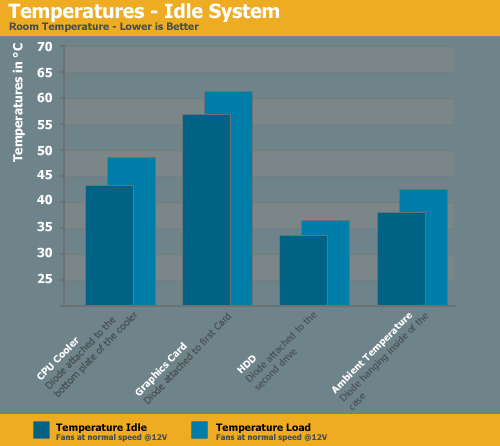Silverstone Fortress FT01
by Christoph Katzer on November 10, 2008 5:00 AM EST- Posted in
- Cases/Cooling/PSUs
Temperatures and Acoustics
We measure the temperatures and acoustics at two different settings: idle and load. For the idle test, we leave the PC sitting at the Windows desktop without any additional running programs. We let the system idle until temperatures stabilize (around 30 minutes) and then take our temperature readings. For load testing, we run the Fur Benchmark for the graphics cards and BOINC for the CPU. In general, the temperature stabilizes after around 20 to 30 minutes, but we run the load tests for 60 minutes and take the highest temperature during this time.

The CPU cooler has an easy job this time with premium airflow directly from above. However, the graphics cards have a more difficult job keeping cool, since there is no fan on the side panel and there are obstructions between the graphics cards and the intake fans. We see the results of this particularly at higher loads; the graphics cards do okay but definitely don't stay cool. Then again, high-end graphics hardware like this tends to run hot at full load.

So what about reversing than directions -- does the Silverstone marketing touting the benefits of positive pressure cooling show up? Compare the two temperature graphs, and the answer is a resounding yes! Besides the fact that reversing the top fan direction required a fair amount of effort, there's absolutely no good reason to change the orientation. Couple in the added benefits of reduced dust accumulation because of the filters, and we have to agree with Silverstone. You may not see such dramatic differences on other cases, but the Fortress FT01 definitely works well in the stock configuration, and modifying the fan arrangement appears to cause more harm than good.

As mentioned already, the current test system definitely is not designed to eliminate noise. As such, most of the noise output comes from the fans on the graphics cards. The fans on the Silverstone Fortress FT01 are not connected to a fan control, so they always use 12V. However, in subjective testing we felt that the case fans were very quiet and should not present a problem for users looking to build a low noise system. Again, we will investigate this further in the future with a different test configuration.










22 Comments
View All Comments
Zepper - Monday, November 24, 2008 - link
I notice that the author didn't bother to convert the measurements into English units - isn't this a mainly American site where only a minority is really fluent in Metric? It is basically a maxi-mid tower of about 19x8x20 (HWD) inches (assuming the values in the Specs. table are accurate) - SST has been known to be inaccurate in their specs tables and this one looks like it was "borrowed" directly from their Web site, so I do my own measurements and weighing.Otherwise and interesting, but not knockout case. Looks too much like Lian Li at first glance, but L-L would seldom round the edges like that.
.bh.
anartik - Thursday, November 13, 2008 - link
Even the best of cases have some design issues and tradeoffs depending on its intended use. I think if you are looking for an air cooling only case or plan to use external WC the Fortress rocks in its simple high tech aesthetics. People whine about $200 for a case but in the scheme of premium, all aluminum cases it’s a pretty good deal. If you want fuzzy dice, uh bling, you can still do it tastefully with a window and some internal lighting. I hope SS offers a windowed version, as they usually do, and it’s not that crappy looking window they put on the TJ07 and others. If not… buy a nice window kit and install it yourself.The one thing I would really question is putting that 180mm top intake right on top the single 120mm exhaust and the overall air flow. I would have to suspect it is going to interfere with the airflow of some vertical CPU coolers. The one thing I would add to that case is a 3 bay intake (i.e. Kama Bay) w/ a 120 or 140mm fan. That might be the solution for the Fortress to provide better air flow to one or more video cards while increasing positive air pressure. IMO positive is the way to go for dust control where the dust is limited to your filtered intakes. Every week or two I wipe off my front panel and maybe every few months the two 140mm intake filters get cleaned. Overall the inside of the case stays clean. Nice case but for a little more money I think Lian Li still has a leg up on Silverstone.
Van Squished - Saturday, November 15, 2008 - link
Well I have just finished building an FT01 installation with 850W PSU, Rampage Extreme M/b Q9550 CPU, two ATI cards in Crossfire mode and two hard disks.The case is brilliant to work with, extremely good finish, and in operation the system is almost silent and I struggle to get any part of it above 42 degrees C even with CounterStrike 2 or Photoshop.
So I would recommend it big time.
NicePants42 - Wednesday, November 12, 2008 - link
Anyone with even the most cursory interest in PC case modding could tell you that the The Silverstone FT01 is a basically a revised version of the Silverstone TJ09 internals with a TJ07-styled exterior.Implying that Silverstone's case designs are/were influenced by Apple implies that you are completely unaware of at least two products that have been highly praised (to put it mildly) by PC enthusiasts everywhere. The TJ07 has been on the market since the spring of 2005, and the TJ09 since the end of 2006.
Making demeaning comments based solely on your own ignorance makes you look...ignorant.
Griswold - Tuesday, November 11, 2008 - link
It has an ashtray! Good for smokers.strikeback03 - Thursday, November 13, 2008 - link
Would go well with this:http://www.geeks.com/details.asp?invtid=SIL-CIGCUP...">http://www.geeks.com/details.asp?invtid=SIL-CIGCUP...
JonnyDough - Monday, November 10, 2008 - link
It's pretty simple. Look at how a wood stove or car works. Air intake, air exhaust. The idea is to get a DRAFT going, using the rising warm air. Cool air should ALWAYS be sucked in through the bottom of the case, where the air is COOLEST. It should be expelled via the TOP of the case, where the warm air is naturally rising. An ideal case would "funnel" the air upward and have a chute blowing out the top like a chimney. As the warm air is condensed, it speeds up - sucking more air in through the bottom. Ideally, the hotter a PC is the LESS fans it would need because the increased temps would create more draft. There's a balance here between manufacturing technologies, voltages, and passive cooling. I believe we're nearing it with better case designs and new manufacturing technologies.JonnyDough - Monday, November 10, 2008 - link
If I do plop down my left arm for a new case, this one will be it. Good job Silverstone!CEO Ballmer - Monday, November 10, 2008 - link
I like this!http://fakesteveballmer.blogspot.com">http://fakesteveballmer.blogspot.com
zShowtimez - Monday, November 10, 2008 - link
Ive had a TJ case for 4 years now, the whole upside down motherboard/kinda BTX style... best case Ive ever owned. Kinda makes me want one of these new ones